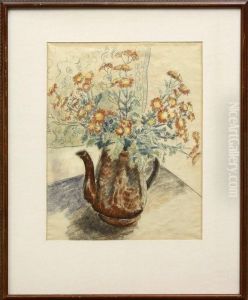Ray Boynton Paintings
Ray Boynton was an influential American artist whose work spanned the first half of the 20th century, encompassing painting, printmaking, and mural creation. Born in 1883 in Sioux City, Iowa, Boynton moved to California in his youth, where he would eventually become a leading figure in the Northern California art scene. His education in art took him to the California School of Fine Arts (now the San Francisco Art Institute) and later to Paris, where he was exposed to the burgeoning European modernist movement, an experience that would subtly inform his work throughout his career.
Boynton’s artistic output is characterized by a diverse range of subjects, including landscapes, animal studies, and human figures, often rendered in a style that combines elements of realism with a distinctive decorative sensibility. His work in the 1920s and 1930s, in particular, reflects a deep engagement with the social and political issues of his time, including labor struggles and the impact of the Great Depression. This period saw him participating in the Public Works of Art Project, a precursor to the more famous Works Progress Administration (WPA) Federal Art Project, through which he created some of his most enduring works, including murals for public buildings that remain on view today.
In addition to his mural work, Boynton was a respected teacher, influencing a generation of artists as a member of the faculty at the California College of Arts and Crafts (now California College of the Arts) in Oakland. His commitment to education and his active involvement in the local art community helped to foster a vibrant artistic culture in Northern California during a time of significant economic and social upheaval.
Boynton's work was widely exhibited during his lifetime, and he was a member of several prestigious art organizations, including the San Francisco Art Association and the California Society of Etchers. Despite his contributions to American art and his role in the Northern California art scene, Boynton's work has not received the same level of recognition in the broader art historical narrative as some of his contemporaries. However, his murals and other works continue to be appreciated for their craftsmanship, historical value, and the unique perspective they offer on American life in the early 20th century.
Ray Boynton passed away in 1951, leaving behind a legacy that continues to be explored and appreciated by art historians and enthusiasts. His work remains a testament to the rich cultural and artistic milieu of Northern California, and his influence can still be seen in the work of artists and educators who were touched by his vision and dedication.
